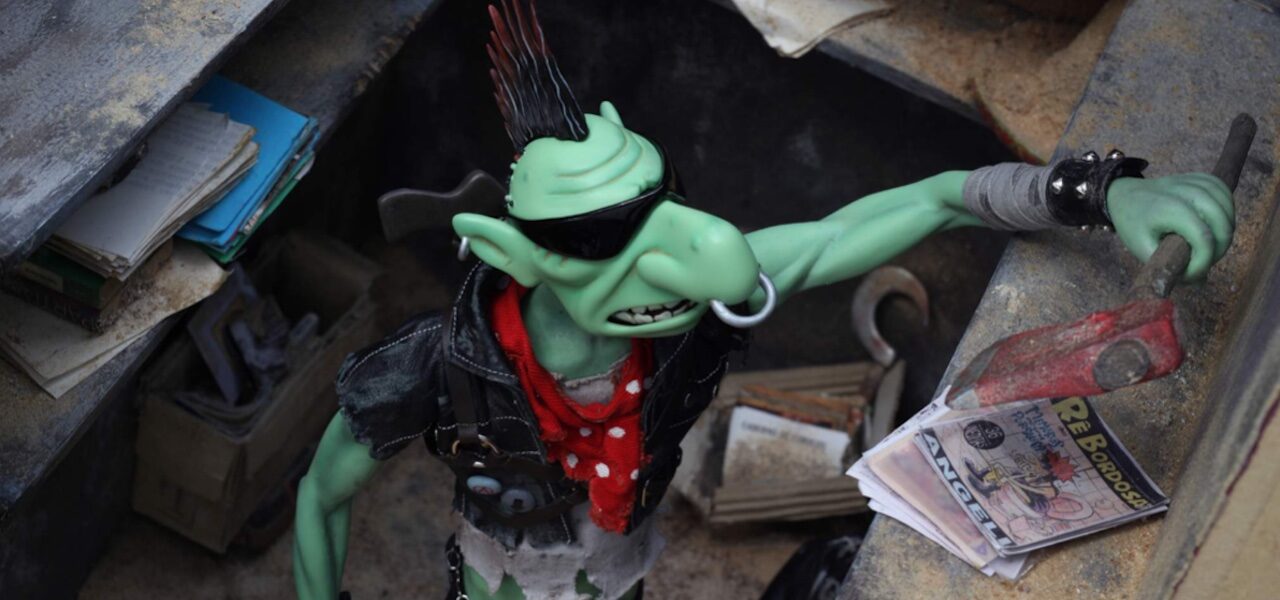
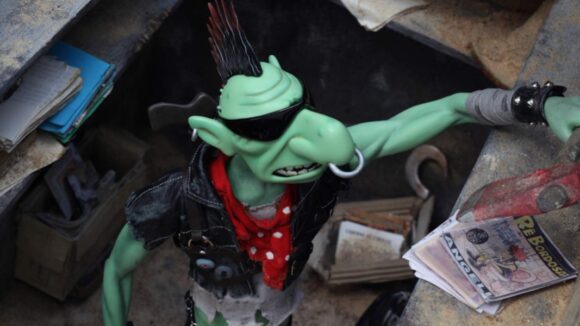
The Brazilian Feature ‘Bob Spit’ Is This Year’s Most Punk Oscar Contender
One of the most refreshing and surprising gems from the animation circuit in 2021, Cesar Cabral’s Bob Spit: We Do Not Like People is unlike anything usually seen in animation features: an ingenious blend of documentary and clay animation, mixed with a punk, road-movie vibe.
Think of Will Vinton fused with William S. Burroughs, with a dash of Mad Max and The Clash, and you get an idea of the film, which won prizes at Annecy and Ottawa.
Bob Spit, which was made for USD$1 million with a crew of about 200, is split into two storylines. In the first, famous Brazilian cartoonist Angeli is interviewed by a camera crew. He speaks of his struggles as an artist and being often stuck with character creations that he’s outgrown — notably his punk alter ego, Bob Spit. He’s killed off popular characters in the past, and now it’s Bob’s turn.
The interview scenes are all done with clay animation yet strive for a strange realism and authenticity. We see moments where Angeli just sits between interviews, scrolling on his phone. Occasionally, we see the boom mic in the frame, or the camera simply rests on a shot of an empty chair while Angeli goes out for a cigarette.
In the meantime, in another space — inside Angeli’s head? — Bob Spit and other Angeli characters, including a group of murderous beings who look like mini versions of Elton John, get wind of Bob’s impending death. He decides he must try to escape from his barren landscape and confront Angeli once and for all.
But is there a creator to find, or just another creation?
Bob Spit is a complex, mind-twirling exploration. On one hand, it’s a loving celebration of Angeli. At the film’s core, though, is the relationship between the artist and his or her creations, and also a contemplation of the broader notion of identity. Identity is fluid, constantly — however subtly — changing during our lifetime. Yet our former selves never fully disappear. They live on within us, despite our best attempts to vanquish them. And characters that Angeli killed off in print (notably the popular Rê Bordosa) continue, as he discovers, to live on inside him.
The feature has qualified for the Oscars this year. While awaiting the nomination announcement on February 8, Cartoon Brew got together with director Cesar Cabral to discuss the film (via email correspondence), and his obvious passion for Angeli and his art.
Cartoon Brew: You made this stop-motion short film Dossiê Rê Bordosa (2008) and the series Angeli “The Killer” (2017). That would require some passion for the subject! When did you first develop an interest in Angeli? What is it about him and his work that appeals to you?

Cesar Cabral: I grew up reading comics, mainly Chiclete com Banana magazine — Bubblegum and Banana, which means eating bananas and bubblegum at the same time. That was a great influence on my entire generation. It was in this magazine that used to be sold on newsstands that I found a production that spoke directly to my desires and discoveries in counterculture.
The magazine was a mix of comics, literature, music, and pop culture in general. When I started working with animation, my first short Dossiê Rê Bordosa was born from the desire to approach Angeli’s universe and create a mix of animation and documentary. At that time, I would never have imagined that this would unfold in different works.
Did you always envision a feature film, or did this idea emerge out of the short film or series?
The idea came up in a conversation with Angeli right after making the short. Until then, I considered it impossible to produce such a complex project in terms of costs and execution time. But I believe that the political moment we were living in, with all the investments in ANCINE (the Brazilian cinema agency) and the now-extinct Ministry of Culture, kind of let us dream that it was possible, and after lots of dedication and hard work, we saw the idea materializing.
The intention of producing the feature was born even before the series, which was in fact a direct invitation from Canal Brasil, a private tv company that focuses on independent national productions.
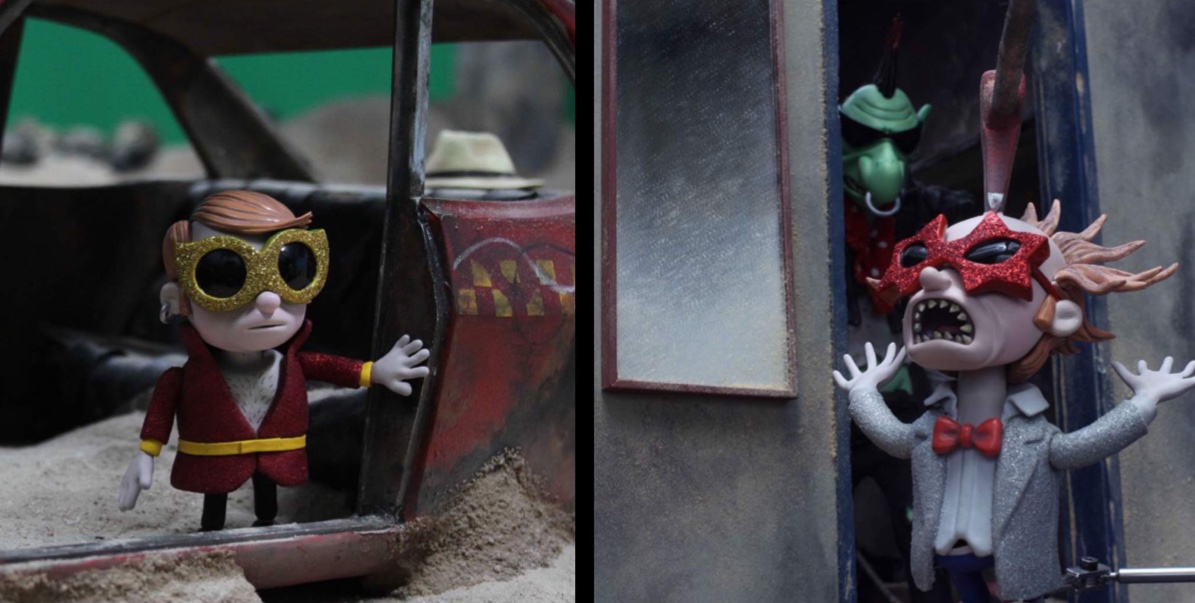
We see fairly consistent animation feature production in Brazil. Based on what I see in the credits, it’s a balance between different levels of government support mixed with private funding. Is it easier to fund a feature, which has more distribution potential, than a short film?
Bob Spit, like most Brazilian productions over the last two decades, was financed through public investments from different governmental sectors, since education and the arts and culture sectors were of great importance to the governments that followed since the late 1990s.
The film was financed by the city and state of São Paulo, but mainly by the federal government through tax incentive systems that used important public companies such as the oil corporation Petrobras, the national development bank BNDES, and the FSA (the national film fund). Short films were not allowed to reach this financial system, but we used to get some calls from the Ministry of Culture and local governments, as well as São Paulo’s state-owned media development company Spcine.
Over the last three years, to be more precise, all this structure and the entire complex system created in the last decades were dismantled by the current federal government, and now most producers either have co-productions with tv and streaming or have closed their doors.
At the core of Bob Spit is the relationship between an artist and his art. In this case, it’s a relationship between the artist and his alter ego. Some of what Angeli says reminds me of the writer Hunter S. Thompson, who once acknowledged the myth about him having finally taken over from reality. Is there a danger when the creation becomes, in a sense, the creator?
Angeli’s nonconformism is one of his issues, so allowing a pre-established work to take care of his artistic production is something he finds unacceptable. Angeli didn’t want to be the guy who made Rê Bordosa or Bob Spit only. His work is constantly changing; he is always aware of the passage of time, and in some ways, in order to move forward, he must disassociate himself from his past.
It doesn’t mean that he will disconnect completely, but that this imposed distance will force him to find new paths. As he himself says in the film, the author is the one who must control his creation, and if he cannot, it is better to murder him!
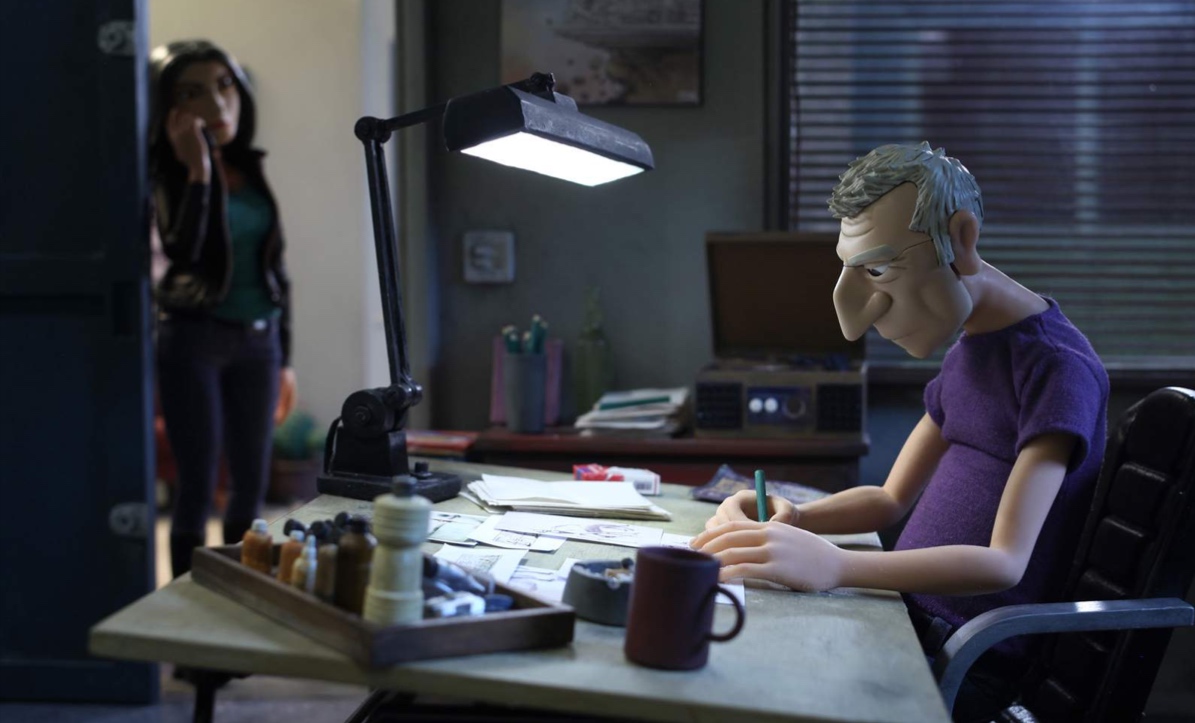
On that line, Angeli the creator is now Angeli the character of Cabral’s creation! How challenging is that when your character is a real person?
Yeah! It was a challenge to create a character from a real person and with a pre-established creative universe. What we did was to maintain a dialogue with reality through the material produced in conversations with Angeli, and to work with one of his actual creations, “The Old Cartoonist,” in favor of the narrative, creating a caricature of the author and how he relates to his characters.
And what about the audience? In a sense, all art, once distributed, becomes owned by the audience. Does the artist or their intentions even matter?
I think that making an artistic work comes from the desire of its creator to express something in which he himself has a particular interest, but that also generates public interest in that portrayed universe. So the first thing that calls the attention of the audience is this, but what will be made of it depends on the perspective that each one can have on the subject.
What was the context of the interview with Angeli? Did you record it as a “normal” interview or was it recorded specifically for the film you envisioned?
At first, I started the interviews in the classic way, with a list of questions and a team that was limited to a camera operator and a recording engineer. Throughout the conversations, which lasted about two years, I adapted and approached Angeli in a more intimate way, looking for conversations that did not have ready answers but that could bring something closer to his personal life and artistic process.
In a way, the fictional part of the film was shaped by the documentary process and vice versa. I think it is important to point out that there are no dialogues written for Angeli. Everything that appears in the film comes from this documentary process, even though we build The Old Cartoonist in his fictional performances.
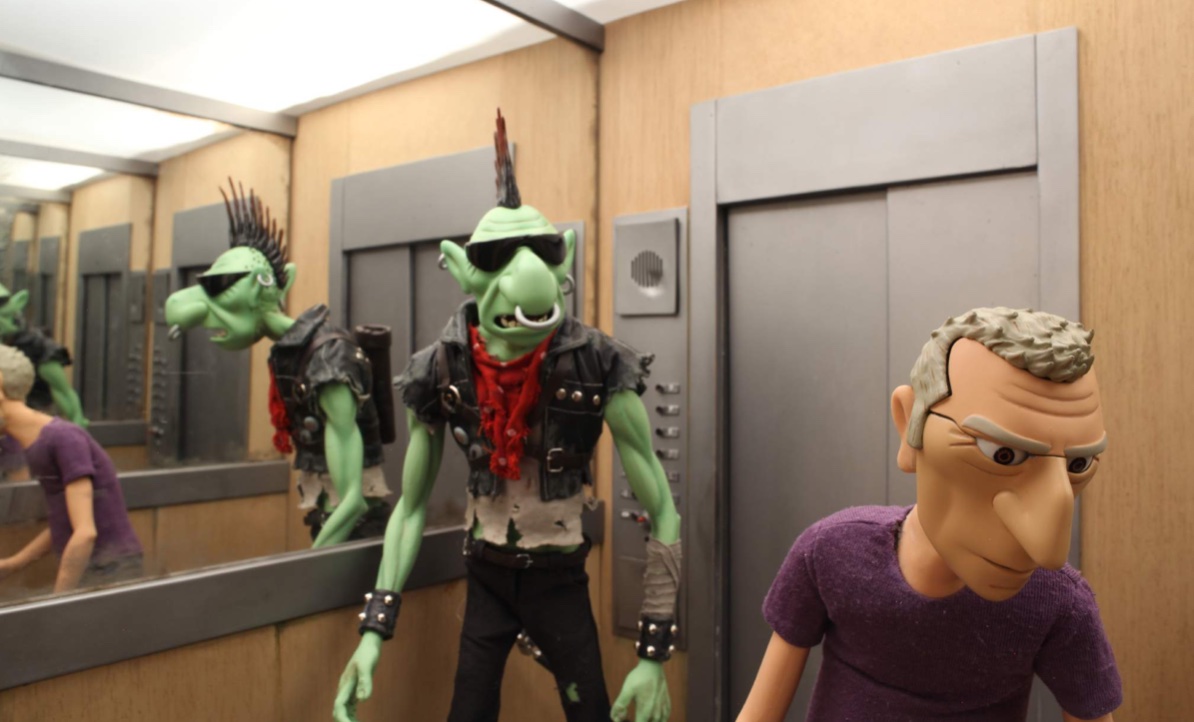
Did you always know that the interview story would be done in clay animation? Did you ever consider doing it as a live-action film? Or would that have made merging the two stories too difficult and maybe a bit disjointed?
From the beginning, it was clear to me that it should be a claymation. I did the same in Dossiê Rê Bordosa. But even considering the stop-motion technique, I wanted to keep things close to reality, in a way that always reminds the audience that we are dealing with the real world. Whether it’s a microphone in the scene, a camera that loses focus, or even more realistic acting in the animation, these elements gave credibility to the real, while at the same time they allowed a connection with the fictional world of its characters.
I knew from the beginning that the film would culminate in an encounter between the creator and his creation, but I always tried to maintain the dilemma of “where fiction begins and reality ends.”
How hands-off was Angeli? I would imagine you know him well enough after the short and series, but does he just sit back and trust where you’re taking it? He’s being interviewed but has no idea what the eventual context of that interview will be. I would imagine it might be hard for Angeli, as an artist, to stop himself from getting involved in the creative process.
Angeli always made a point of making it clear that the film was an artistic process of mine and my team, and therefore he wouldn’t involve himself directly, but I believe that this freedom and trust were conquered since the Dossiê Rê Bordosa short. The works I created with Angeli always sought a dialogue with the universe he created, but I must admit that showing anything we created to him is always difficult and delicate for me.
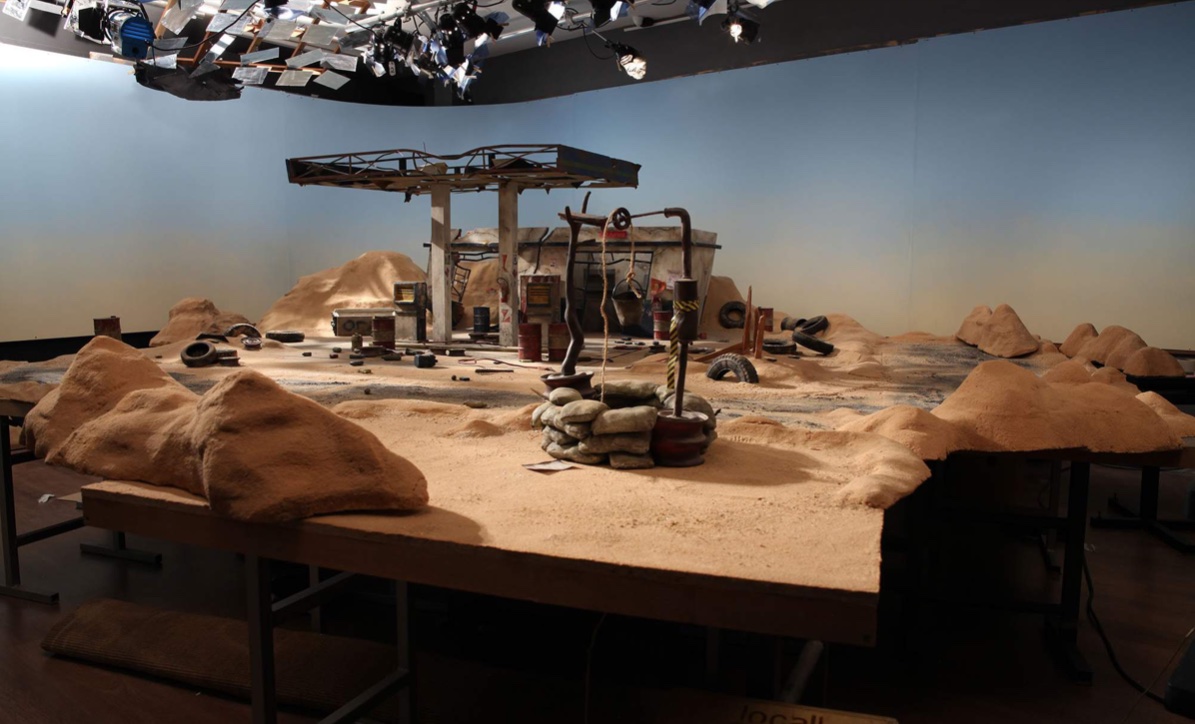
Were you surprised by the film’s success? Certainly, it would be attractive to Angeli’s fans, but Bob Spit also captured the attention of many audiences that perhaps didn’t know him at all. What do you think was the appeal for those audiences?
As I said before, it is very difficult to imagine how a film will be received, and I was very unsure about the reactions of the international audiences, since I knew they were unaware of Angeli’s work or his importance to the political and cultural formation of my generation in my country. But I was also worried if this kind of dark comedy, and the kind of anarchism that Bob Spit represents, would work nowadays.
For the first doubt, Angeli’s not being internationally recognized, we decided to invest in a narrative that could reinforce the idea of a middle-aged artist in crisis with his work. For the second, with Bob Spit and the other characters’ rebellious and nonsense personalities, we really took the risk.
To tell you the truth, we are proud of the good reception. Maybe it is due to the fact that the film deals with universal themes: it’s an author in crisis with his work versus a punk that doesn’t accept the imposed reality. In a way, these themes unfold in a broader way in young people’s nonconformity with the pre-established reality, or our frustrations with the world we live in or believe in. I think this is synthesized with pop devouring punk, for example.
Speaking of Angeli’s fans, did you get feedback from that community? Were they happy with the film, or did they have unsolicited notes to share with you?
The film was well received by Angeli’s fans. There is a nostalgia that is not limited to the characters, but [linked also] to the music and references that we brought from that time. It is always very delicate to work with characters that have already been consolidated, whether due to the transformation of the 2d line into a 3d sculpture or even the voice we give each character.
The most significant comment I received was that Bob should spit more throughout the film, because, after all, he has a lot to dispute. But I preferred to leave the “spit” for a special moment in the story, and leave the continuation of the story to the audience!
“Bob Spit: We Do Not Like People” has been acquired for North America by Outsider Pictures, which gave the film an Oscar-qualifying theatrical run in December.
